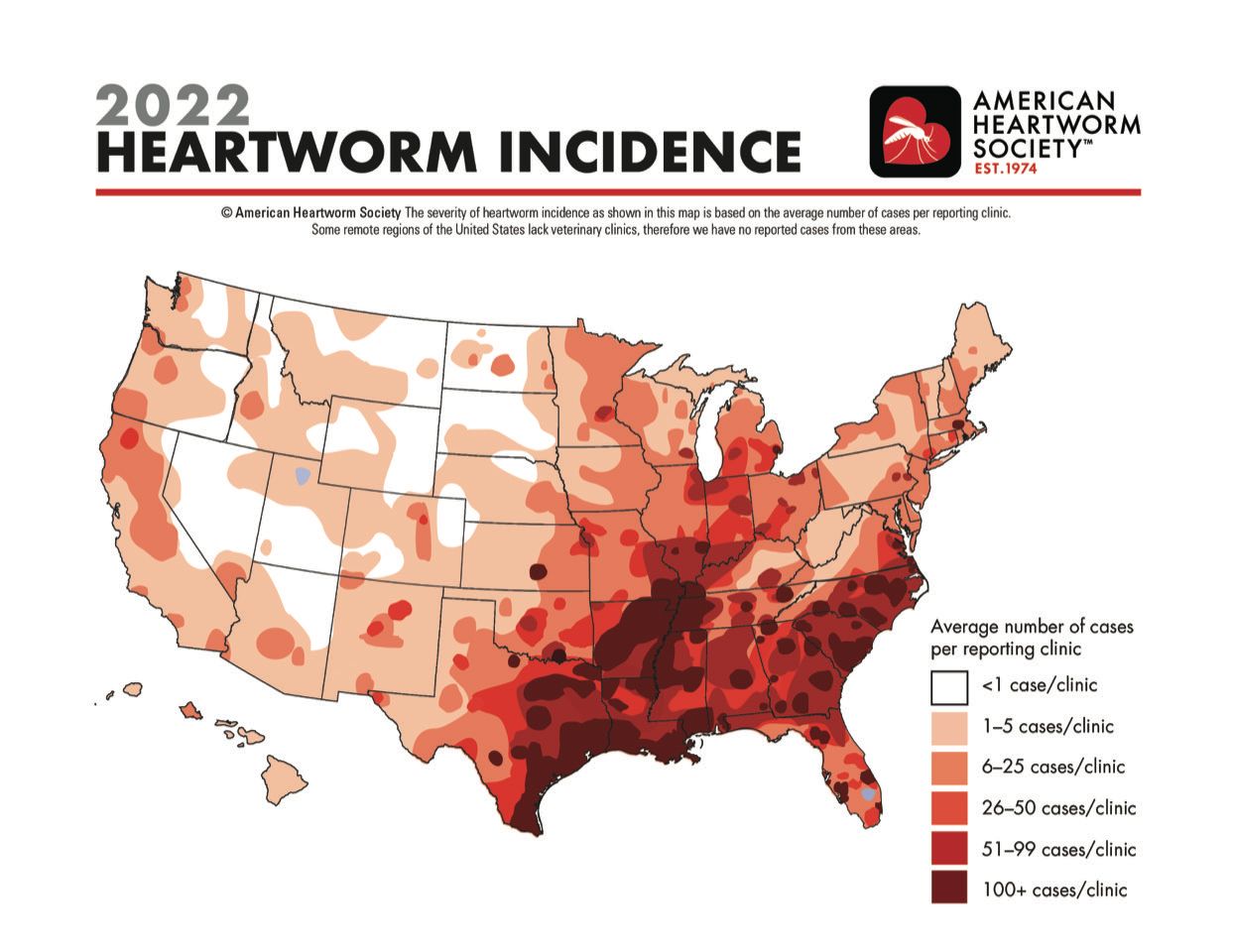New Heartworm Incidence Map shows increase in parasitic cases
The American Heartworm Society works with veterinary practices and shelters that voluntarily submit data from heartworm antigen tests to create this resource every 3 years.
Image courtesy of the American Heartworm Society.

New data from the American Heartworm Society (AHS) show an increase in heartworm prevalence in certain areas of the country. The organization’s newly released 2022 Heartworm Incidence Map reveals upward trends in previously known heartworm “hot spots” as well as locations where cases of these parasites were once rare.1
The map was drawn following the AHS’ most recent heartworm incidence survey, which is conducted every 3 years. The society works with veterinary practices and shelters that voluntarily submit data from heartworm antigen tests run over the course of the survey’s previous year. This latest survey was conducted in early 2023 and reflects data from heartworm testing conducted throughout 2022.
The 2022 map shows the leading states for heartworm incidence continue to be those in and adjacent to the lower Mississippi Delta, which historically experiences a convergence of conditions fostering widespread heartworm infection. The region bears a climate conducive to mosquito proliferation along with the presence of untreated dogs and wildlife that serve as reservoirs for infection.
“The states with the highest density of diagnosed heartworm cases in the latest survey were Mississippi, Louisiana, Texas, Alabama, and Arkansas,” said AHS president Jennifer Rizzo, DVM, in an organizational release. “Meanwhile, Arkansas, Mississippi, Texas, Georgia, Florida, Tennessee and the Carolinas all saw expansions of high-density areas on our incidence map.”
States with historically low heartworm rates also saw unexpected increases and the development of new “hot spot” areas within their borders. These included Washington, Oregon, Kansas, North Dakota, Massachusetts, and Connecticut. In addition, urban areas such as Seattle and Boise in the Northwest; Bismarck in the Upper Midwest and Tucson in the Southwest all saw significant increases in heartworm rates. Although no single reason can be attributed to these changes, factors involved are believed to include a greater influx of heartworm-positive animals from out-of-state, higher testing rates, higher infection rates—or all 3 of those factors, according to AHS.
Along with submitting their numbers, practitioners completed a brief multiple-choice AHS survey on trends noted since the previous survey, which was conducted in early 2020. In this survey, participants were asked whether heartworm rates in their area have stayed the same, increased or decreased. The findings were as follows:
- Half of respondents (53%) said heartworm rates have remained stable. Significantly more respondents said heartworm rates have increased (29%) than decreased (17%).
- Among those who saw rates rise, almost one-third (32%) blamed the influx of heartworm-positive pets to their area. Poor compliance with heartworm prevention (27%) followed closely, along with weather conditions that caused an increase in mosquitoes (22%).
- Among respondents who saw heartworm rates drop, changes in pet-owner behavior, including increases in pet owners administering heartworm preventives (33%) and improvements on preventive compliance (31%) were the most cited reasons.
The FDA recommends prescription heartworm preventives approved by the agency as the best way to combat heartworm disease in dogs. The FDA has also approved injectable melarsomine dihydrochloride for killing adult heartworms in canines, and a topical combination of imidacloprid and moxidectin for ridding a dog’s bloodstream of microfilariae.2
“While the past 3 years have been tumultuous for both the veterinary profession and our clients, the good news is that heartworm disease continues to be almost 100% preventable with faithful year-round heartworm prevention,” said Rizzo, in the release. “Whether it’s educating new pet owners about heartworm prevention or reminding long-time owners of its importance, it’s clear that the AHS and the veterinary profession must work together to continue to work together to raise awareness of this devastating disease.”
The new AHS map can now be downloaded on the organization’s website and compared with maps generated every 3 years since 2001.
References
- New American Heartworm Society heartworm incidence map reveals upward trend in heartworm cases. News release. American Heartworm Society. April 10, 2023. Accessed April 20, 2023.
- https://d3ft8sckhnqim2.cloudfront.net/images/HW_survey_news_release.pdf?1681234747
- Keep the worms out of your pet’s heart! The facts about heartworm disease. FDA. December 22, 2022. Accessed March 17, 2023. www.fda. gov/animal-veterinary/animal-health-literacykeep-worms-out-your-pets- heart-facts-about-heartworm-disease









